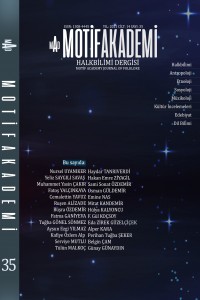HEDİYELİK EŞYALARIN BİR KÜLTÜR OBJESİ OLARAK DEĞERLENDİRİLMESİ: KONYA ÖRNEĞİ
EVALUATION OF SOUVENIRS AS A CULTURAL OBJECT: CASE OF KONYA
Author(s): Emine Nas, Mitat KandemirSubject(s): Visual Arts, Cultural Anthropology / Ethnology, Sociology of Culture
Published by: Motif Halk Oyunları Eğitim ve Öğretim Vakfı
Keywords: Seljukian; Konya; handicrafts; culture; souvenirs;
Summary/Abstract: Culture; It is a concept that creates and maintains the material and spiritual values created by societies throughout history. One of the most important conductors influencing the concept of culture, which is nourished by the characteristic features of the life cycle of nations and giving it a unique quality, is the society's perspective on art. Social interactions, economy and geographical features play an active role in the formation of art values of societies. Each country's unique art school is a reflection of its culture. In this context, the Anatolian Seljuk period has a rich art spectrum. The art school of the Seljuk period has developed within the scope of architecture and handicrafts and exhibits a rich profile including ceramics, wood, stone, textile, glass, metal, book decoration arts. The ornamental features and design style used in the branches of art formed the naive identity of the Anatolian Seljuk art. In this context, the city of Konya, as the capital of the Anatolian Seljuk state, contains many of these movable and immovable cultural assets. Especially Mevlâna and Mevlevi, which has cultural importance with the unity of belief, art and philosophy, has been a driving force in Konya's prominence with its handicraft productions and products containing cultural elements on a global scale. This handicraft product group, which is very effective in the tourism activity of the region and in which cultural codes are transferred, has the mission of being a "promotion and transfer" tool for Konya tourism, especially in the winter months. In the study, within the sample determined under the title of "Evaluation of Souvenirs as a Cultural Object: The Case of Konya", the feature of handicraft products as "cultural objects" in commercial platforms and their design values were tried to be examined. In this context, it has been evaluated what kind of a design language the souvenirs in the current market exhibit under the influence of cultural indicators.
Journal: Motif Akademi Halkbilimi Dergisi
- Issue Year: 14/2021
- Issue No: 35
- Page Range: 1092-1103
- Page Count: 12
- Language: Turkish

